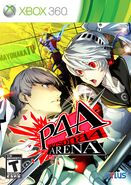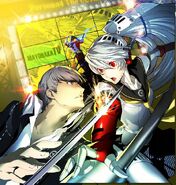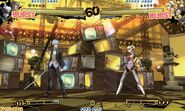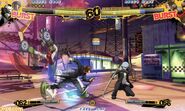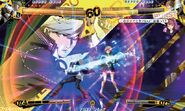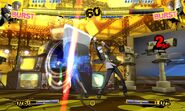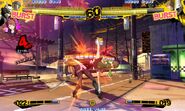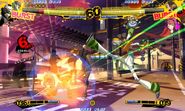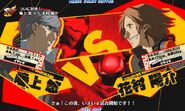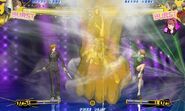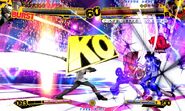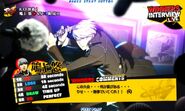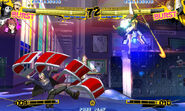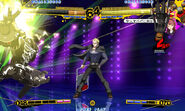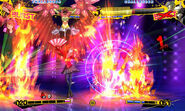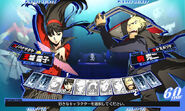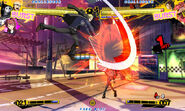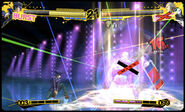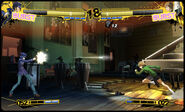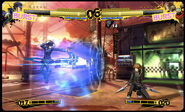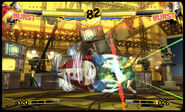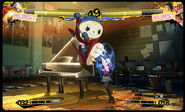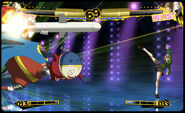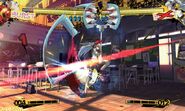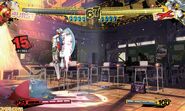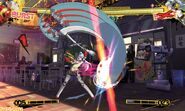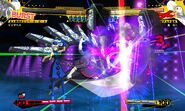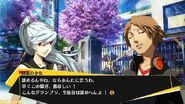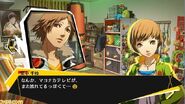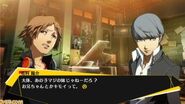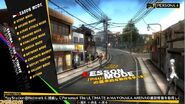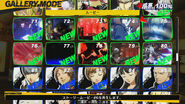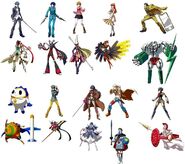Persona 4 Arena, also known as Persona 4: The Ultimate in Mayonaka Arena in Japan, is a 2D fighting game by Arc System Works, developed under the supervision of Atlus's P Studio. It is directed by Katsura Hashino and scored by Shoji Meguro.
It is a spin-off to both Persona 3 and Persona 4, set immediately after the events of Persona 4, featuring characters from both games. As such, it is strongly recommended to finish both Persona 3 and Persona 4 first, or else Arena will spoil major plot points from both games.
A sequel, Persona 4 Arena Ultimax, was released.
Сюжет[]

Persona 4 Arena E3 Trailer
Trailer.
The game contains twelve different story modes from each of the cast members. The selected character acts as the game's protagonist, and the story of the game is told through their perspective via visual novel cutscenes, with the outcome affected by the character chosen. However, Labrys (whose story is a visual of her past) and Shadow Labrys (who does not have a story mode) are not acting protagonists. The following is a general summary based on all the story modes:
The story starts 2 months after the events of Persona 4 but before the epilogue of Persona 4 Golden, meaning that Arena is set in May 2012.
At the start of Golden Week, Yu Narukami returns to Yasoinaba and reunites with Dojima, Nanako and his friends. But soon Chie hears a rumor that the Midnight Channel is airing again and tells Yosuke and Yukiko. The three of them and Yu (coincidentally) see it. At the same time, Rise, Kanji and Teddie go missing and Naoto is busy on a mission. The following day, they head into the TV world and find themselves stuck in a tournament held at their high school where they must fight each other to advance, but during the tournament they see a mysterious girl who claims to be their student council president as well as three Persona-users they've never seen before.
Mitsuru is now head of a secret spec ops squad known as Shadow Operatives working with the government consisting of herself and some of her old SEES colleagues. On a mission to escort top secret cargo, the airplane she's on is hijacked. Aigis manages to take down all the hijackers on her own but one of the cargo is stolen: the 5th generation anti-Shadow humanoid weapon, Labrys. They track her down to Yasoinaba and enter the TV world, joined by Akihiko Sanada, having just arrived from South America, who shows up to help after Aigis picks up readings from inside. Naoto is hired by public safety to spy on the Kirijo Group and Shadow Operatives. She follows them into the TV.
As Elizabeth continues on her journey, she stops by at the gate of death to defeat Erebus, who comes back about once a year (she picks it up with one hand, throws it through a portal to the moon, then kills it in one hit with Thanatos). She heads over to the TV world when she feels all the Persona users gathering there, hoping that she may find something in the strange phenomenon may be able help her to defeat Erebus for good so that she could save the boy who became the seal to protect humanity. Elizabeth encounters two of the boy's successors, one that she had befriended and given the Velvet Room's guidance under her supervision, and another who had also received the Velvet Room's guidance but this time under Margaret's supervision.
As the Persona users get to the Announcement room where Rise is being held, they discover Labrys and soon learn about her as her Shadow reveals her true self.
Labrys was created in 1999 at the Kirijo Ergonomics, lab and most of her development was done through forcing her to fight other models of her series. She grew close to one of her "sisters", Unit 024, but was forced to destroy her as well. She eventually escaped the lab, dealing extensive damage to it in the process, but was recaptured and sealed away. After vanishing from Mitsuru's plane, she was tossed into the TV world and her Shadow Self created the tournament to let other people feel what she felt.
Пользователи Персоны побеждают Теневую Лабрис, и Лабрис принимает ее, превращая Тень в ее Персона, Ариадну. Однако, когда они готовятся уйти, истинный вдохновитель за всем берет ее под контроль и заставляет атаковать всех. Фууке удается вовремя добраться до Ясоинабы и прервать его связь, но он убегает. Вдохновителем является человек без Персоны, который не может войти в мир телевидения, но сотрудничает с чем-то нечеловеческим, что может формировать сдвиг и притворяться тенями различных персонажей. Их цель - мысленно ослабить пользователей Персон, чтобы их Персоны вернулись к Теням; им нужно собрать сильные Тени для своего «Проекта», и возвращение сильных Персон пользователей Персоны сделает исключительно сильные Тени. Оба они убегают, и Мицуру говорит пользователям Персоны Инабы забыть обо всем и оставить остальное дело им. Ю убеждает всех «подчиниться» приказу Мицуру, но она и Айгис легко видят его действия. Несмотря на это, они решают позволить им делать то, что они хотят, хотя оба также планируют сделать все возможное, чтобы уберечь их от опасности. Прежде чем они уйдут, Лабрис снова встречается с группой Инабы и говорит им, что она уйдет и присоединится к группе Мицуру, чтобы поймать преступника, чтобы она могла защитить своих новых друзей, в то время как она и Айгис клянутся найти свою «мать».
После того, как они уходят, Ю и Йоске рассказывают всем, что они реформируют Следственную группу. Все готовятся к тому, что будет дальше.
The penultimate boss in most character's story mode is Shadow Labrys. The final boss of the Persona 4 cast is a brainwashed Labrys with Ariadne. The final bosses of the Persona 3 characters and Naoto is their own fake Shadow. In Teddie's case, he has an extra fight against Kanji who thinks everything is a dream and shows up looking for a fight.
Elizabeth's Story Mode ends with her gaining insight on the nature of the Wild Card from Yu and Aigis, and she gains her own Fool Arcana, signifying the start of a journey.
In addition, Yu, Chie, Yukiko and Kanji are given choices in specific parts of their story where they are given prompts to respond to. For Yu, this is has no bearing on his story (though specific choices can lead to an extra scene with Margaret). For the others, their choices can either lead them to their true ending, or a non-canon joke ending.
Персонажи[]
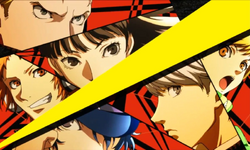
Several members of the cast from Persona 4
- Основная статья: List of Persona 4 Arena Characters
As a sequel to Persona 4, the game sees a return of the original cast as well as several characters from Persona 3. Each of the main characters were also given titles.
- Ю Наруками: The Sister Complex Kingpin of Steel Шаблон:J. "Sister Complex" references Yu's love for his cousin Nanako Dojima—also known as "Nanakon" (ナナコン) in Japanese fandom. "Kingpin" may be a reference Yu's fan nickname in the Japanese fandom (Banchō).
- Yosuke Hanamura: Captain Ressentiment Шаблон:J is a reference to Yosuke's resentment towards a society that hates him for being the son of a man that destroyed business for the Central Shopping District.
- Chie Satonaka: Spunky Dragon with Deadly Legs Шаблон:J, translated literally as "the dragon with leg martial skills who surpasses all males." Her title in the original promotional video is The Carnivore Who's Discarded Womanhood Шаблон:J, a reference to her undying consumption of meats and being a fan of martial arts.
- Yukiko Amagi: The Unconquerable Snow Black Шаблон:J is both wordplay of "Snow White," due to Yukiko's name meaning "snow," and a reference to Yukiko's Castle. "Black" also refers to her hair color and a Japanese stock character known as "haraguro" (腹黒), who talks amicably but has some weird or cruel ideas in mind.
- Kanji Tatsumi: The Bloodcurdling Beefcake Emperor Шаблон:J, a jab at his sexual insecurities. Gachimuchi is a Japanese slang term, referring to very masculine homosexual men.
- Teddie: The Beast in Heat Шаблон:J. The kanji translates literally to "Predator of Sexual Desires," and the furigana translates to "Beast of Libido". It is a reference to his repeated attempts to hook up with the female members of the Investigation Team.
- Naoto Shirogane: The 2000 IQ Killjoy Detective Шаблон:J. "KY" is a Japanese slang abbreviated from the phrase "Шаблон:J," which means someone acting improperly in the wrong situation. Yosuke uses this slang on Naoto during their school trip to Tatsumi Port Island in the club in the Japanese version.
- Akihiko Sanada: The Two-Fisted Protein Junkie Шаблон:J refers to his boxing career and his love of protein.
- Mitsuru Kirijo: The Imperious Queen of Executions Шаблон:J, a reference to Mitsuru's ice executions. Also possibly a reference to the failed Kyoto minigame scene.
- Aigis: The Heartless Armed Angel Шаблон:J, a reference to her being a humanoid android with heavy weaponry.
- Labrys: Yasogami's Steel Council President Шаблон:J, a reference to her being an android and the Student Council President.
- Shadow Labrys: The Raging Bull of Destruction Шаблон:J, a reference to her familiar Asterius and her desire for destruction.
- Elizabeth: The Lethal Elevator Attendant Шаблон:J refers to her previous role as Igor's assistant in the Velvet Room, which in Persona 3 took the form of an elevator.
Additional Character Dates[]
The Japanese Arcade versions had additional characters that were released overtime.
- Labrys: 22 марта, 2012
- Elizabeth: 5 апреля, 2012
- Shadow Labrys: 19 апреля, 2012
- Yukari Takeba: Location Test from August 16 to August 18, 2013
- Junpei Iori: Location Test from August 16 to August 18, 2013
Геймплей[]
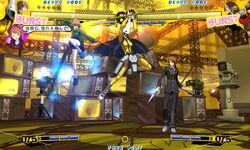
Чие Сатонака и Йосуки Ханамура in gameplay; showing the first HUD displays in the initial build of the game.
Persona 4 Arena follows the style of modern anime fighters, in the same vein of ones developed by Arc System Works by largely building upon the engine used for BlazBlue (thought with some aspects of Guilty Gear mixed in). In addition, many fighting game elements of Persona 4 Arena have been streamlined in comparison to its peers such as simpler controls. However, one notable trait is that this fighting game puts very heavy emphasis on the avatar/summon/puppet-based system, in that two different characters are to be controlled.
The controls of combat consists of four buttons: A (Light/Weak Attack), B (Strong Attack), C (Persona Attack) and D (Persona Rush) and movement input via stick, d pad, or otherwise. A combination of the buttons result in other functions like the Furious Action. Special moves (or Sure-Killing Arts in Japanese circles), which are universally known as Skill Attacks/Skills in this game, are performed by the correct motion and button input. Special moves and supers, can inflict chip damage when they are blocked (a small amount of percentage of its original damage on hit), but in the former case they can build a small amount of SP/meter if they miss/are whiffed.
Through a number of very recent fighting games made around the same time as P4U, an Auto-Combo can be performed by repeatedly pressing A in a neutral position in order to appeal to beginners, which is known as the Renda Combo (lit. Barrage Combo) in the Japanese versions. The second and third inputs are alternate unique "dial-combo" normals which can be cancelled other higher-tiered moves freely. The fourth and fifth inputs are instead, a preset Skill to Super Cancel followup. 15 extra SP and a bit of the Burst Gauge is rewarded for a successful 3-input Barrage Combo, and the full auto-combo can only occur if all attacks connect on hit. However, not all characters' auto-combos can be cancelled freely into other attacks outside of their preset route.
Personas in this game act as a passive-avatar system; moves are used to call them out only for a brief action before they disappear. If either the users or their Personas are struck during any Persona-based action, they will instantly vanish and a Persona card will be depleted. Once all Persona cards are depleted, a Persona Break can occur. A Persona Break will occur barring the usage of the target's Persona for a set amount of time, though Persona-based moves can be done right after when hit (even when a Persona Break occurs).
Additionally, each character has their own reversal referred to as a Furious Action (known as the Reversal/R-Action in Japanese). As the name implies, they are defensive special moves that allow the character to overturn the tide of battle like having an anti-air move with invincibility frames or a counterattack. Furious Action converts the player's life into blue life which can be healed over time as long as the player is not hit; overall, blue life is a unique mechanic new to fighting games in general, where it allows for taking chip damage at 1 HP to not kill a player. 5% of one's HP is converted into blue health whenever the aforementioned Super Cancels are performed.
Persona 4 Arena also has its own variation of an All-Out Attack that can be performed, and followed up with a new mechanic called an All-Out Rush, a mini version involving only one character. This functions as a universal overhead attack with autoguard/guard point properties and an additional input if the initial overhead connects, which causes stagger on grounded hit or a wildly-flung ground bounce on air hit; if the former hit effect successfully occurs, then the All-Out Rush allows for the player to knock foes away or launch them into the air depending on the followup input, all with button mashing for extra hits and a free Fatal Counter hit.
Imported from the Persona series in general are Status ailments. Status ailments last a certain amount of time and are also negated if the user is hit. The only exception to this is Rage/Berserk, which only goes away after a set amount of time. Only one status ailment can be in effect at a time, and can be cancelled out by another.
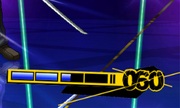
The SP Gauge.
Like in the series, SP is a resource that can be expended to execute various moves with the relevant input and SP amount. Such commands involve Skill Boosts (a.k.a. EX Moves) SP Skill Attacks (a.k.a. Supers/Super Sure-Killing Arts), Guard Cancels, and One More! Cancels (a.k.a. Roman Cancel/Rapid Cancel; ends current attack animation as long as the attack connected).
Characters can perform difficult-to-land Mortal Blows/Instant Kills which instantly defeats the opponents. They can only be performed on match point, and it consumes 100 SP.
When a character's life is 35% or less, they enter an Awakening State, signified by a red SP Gauge and a Persona-style summoning cut-in in the background. In this state, the SP Gauge is extended to 150 and gains an extra 50 immediately, the character gains a defense boost, and enables a new Super or two exclusive to that state, similar to certain desperation modes in past fighting games. It is possible to enter Awakening State through blue health.
Below the Life Gauge is a Burst Gauge. When full, the player can Burst, which blows back the opponent with invincibility frames if they are in close proximity. When it is used when your opponent is hit and you are in neutral position, your SP Gauge maxes out and your Burst Gauge takes less time to refill. If it is used when the player is attacking, it causes a One More! Burst, an un-techable launcher that up-scales damage following it. If it is used while the player is in hit stun, bursting has no benefits other than peeling the enemy off the player. All Bursts count as Persona moves, thus if the player cannot use their Persona, via Persona Break or Silence, they cannot burst.
Other notable functions involve Evasive Actions, forward moving dodges with hit invincibility akin to rolling, Hops, Teching/Ukemi (Passive Falling), Air Turn (a universal mechanic new to fighting games), and a universal Sweep (akin to Guilty Gear but not like other fighting games where sweeps are crouching normal attacks).
Console Release[]
The console release of Persona 4 Arena is split between several different game modes. Lesson Mode teaches the player basic and advanced system mechanics within the game. Story Mode follows the story of Persona 4 Arena through each of the character's perspectives. Arcade Mode is the arcade release of the game and serves as an abridged version of the game's Story Mode. Score Attack Mode is a much harder Arcade Mode where the player goes through every character in the game on a special difficulty setting that is more intense than Hell difficulty. The characters are fought in the following order, regardless of player character: Yosuke, Naoto, Yukiko, Teddie, Kanji, Chie, Mitsuru, Akihiko, Aigis, Yu, Shadow Labrys, Labrys and Elizabeth. Each character also has a specific set of changes that make them more boss-like to increase the difficulty even further. After every four characters defeated, the next four will have a more aggressive AI than the previous, which also increases the difficulty over time.
| Character | Score Attack Mode Details |
|---|---|
| Yosuke Hanamura |
Sukukaja: Permanently active AI Aggression: High |
| Naoto Shirogane |
Fate Counter: Now lowered by all attacks AI Aggression: High |
| Yukiko Amagi |
Fire Break: Permanently active Fire Amp: Permanently at Level 8 Fan moves are thrown three at once. AI Aggression: High |
| Teddie |
Circus Bear: Teddie now runs across the screen 3 times instead of 1, damage and speed roughly doubled AI Aggression: High |
| Kanji Tatsumi |
Grab attacks now do roughly triple damage Gains a new special move, a very fast dropkick with super armor AI Aggression: Very High |
| Chie Satonaka |
Power Charge: Permanently at Level 3 AI Aggression: Very High |
| Mitsuru Kirijo |
All attacks now cause either Freeze or Charm status AI Aggression: Very High |
| Akihiko Sanada |
Cyclone Gauge: Permanently at Level 3 Electric Fists: Permanently active AI Aggression: Very High |
| Aigis |
Orgia Mode: Permanently active and unlimited meter Megido Fire EX: The flames hit thrice as much before throwing the target back into the ground Ammo count increased to 999 AI uses Heritage Liberator Palladion (Low Probability) AI Aggression: Extremely High |
| Yu Narukami |
All attacks can now be canceled into each other Electric attacks have a higher probability of inflicting Stun AI uses Myriad Truths (Low Probability) AI Aggression: Extremely High |
| Shadow Labrys |
Doubled overall damage output AI uses Labyrinthos Gate (Medium Probability) AI Aggression: Extremely High |
| Labrys |
Axe Gauge: Permanently at maximum level (red-colored axe) AI uses Weaver's Art: Inquisition (Medium Probability) AI Aggression: Extremely High |
| Elizabeth |
HP: Increased from 7500 to 22500 Invigorate: SP gain rate increased by roughly quadruple Diarahan: HP now fully regenerates Mahamaon & Mamudoon: Now activate instantly, no longer requiring a timer Ghastly Wail: Damage increased to 7500 normally, and 44444 if the opponent has Fear status inflicted on them (instant death) AI uses Megidolaon, but now activates with just 1 hit instead of 3 (High Probability) AI Aggression: Ultimate |

The 1.02 patch icon.
Versus Mode is the local multiplayer mode. Network Mode is the online multiplayer mode split between Ranked Matches and Player Matches. Finally, Challenge Mode has the player going through each character's moves from basic commands to basic combos to advanced combos, the final challenge being a test of how they understand a certain character's moves or hitting an extremely high combo to produce a high damage count.
The original arcade version eventually has received patches that included characters from time to time, but eventually for both the arcade and console versions, a 1.02 patch came with slight balance tweaks to the system mechanics, small bugs, and all characters, and is identified with a small icon on the lower right of the screen. Thus, on console it is technically impossible to play 1.00 and 1.01.
Галерея[]
- Boxart
- Screenshots
- Artwork and Sprites
Trivia[]
- P4U is the first game to not feature the Shin Megami Tensei label in its overseas title, ever since Shin Megami Tensei: Nocturne was localized in North America and Europe.
- P4U is the first title in the Persona series to be released on Microsoft's Xbox gaming hardware.
- P4U's story takes place in spring 2012 - the same year the game's Arcade version was released.
- Despite dropping "The Ultimate in Mayonaka" from the game's title outside of Japan, the original name appears in the intro movie in all regions. Similarly, the default system voice will always refer to Teddie by his Japanese name of Kuma, even when the language is set to English.
- Also, a direct translation of the Japanese name of the game would be Persona 4: The Ultimate in Midnight Arena.
- In most official material, the game is abbreviated as "P4U" in both Japanese and English to not only refer to the "Ultimate" in the Japanese title, but to prevent it from being mixed up with Persona 4: The Animation, in which both The Animation and Arena via English localization can be abbreviated as P4A.
- Despite taking place after Persona 4, the Investigation Team are shown with their initial Persona, instead of their ultimate ones unlike Mitsuru and Akihiko, as well as Aigis being shown still using Pallas Athena. This, however, can easily be explained as obtaining their ultimate Persona is optional in Persona 4. Also, since Aigis and Yu are both users of the Wild Card, they may have just recreated Izanagi and Pallas Athena through fusion. However, this still does not explain why Teddie does not have his canon Persona, when it transfigured into its ultimate form, Kamui, by unlocking the good ending of Persona 4. It is possible the Investigation Team don't have their ultimate Personas because Persona 4 Golden has them acquire new third tier Personas, likely to accommodate people who haven't played P4G & wouldn't have gained the new Personas. Aigis may also have Athena instead of Orpheus for similar reasons, to accommodate players who haven't played The Answer.
- Yu, however, uses Izanagi-no-Okami during his Instant Kill, and Aigis uses Palladion (albeit heavily modified) during hers. In Aigis' case, she oddly de-evolves her Persona instead of evolving it.
- Interestingly enough, each character has voice clips in their sound test of them calling the names of their initial and ultimate Personas. It was probably intended for each character to choose between their Personas but, probably due to time constraints, this was cut.
- Arc System Works originally wanted Ryotaro Dojima as one of the playable characters during the pre-planning stages when they were deciding on the cast. Takumi Iguchiya joked that instead of a Persona, he would summon Nanako Dojima to his aid, possibly ending up as a joke character.[1] Nanako herself was then proposed as a playable character, but both decisions were strongly rejected by Atlus.[2]
- Persona 4: Arena is the first non-BlazBlue fighting game to use the Fatal Counter system, as well as the first to make use of an un-tech timer outside of training mode.Шаблон:Fact
- This is also one of the first fighting games to make use of a universal auto-combo system that involves pressing a single button to perform an automatic 5-input combo for beginners. Other fighting games made alongside P4U's time involve this very type of system as well which has carried on to future fighting games.
- This is also the first fighting game to also count the very first hit in a combo; most prior fighting games have instead counted from the 2nd hit onward.
- This is one of three PlayStation 3 games to be region locked.
- A majority of characters in this game have skills/spells either used without a Persona, or skills/spells not learned by their Persona(s) naturally. Some also do not retain certain skills used by their Personas in their original games as well.
- Yu's Izanagi cannot learn Ziodyne and Swift Strike, but it's possible in Yu's case as the main character in the original Persona 4 and Persona 4 Golden through fusion to re-create an Izanagi with both those skills.
- Yosuke uses Garudyne in the style of his follow-up attack.
- Chie uses Rampage without the use of a Persona (in the style of her critical hit), as well as Skull Cracker. Her Instant Kill is also her original follow-up attack.
- Likewise, she oddly does not have any ice-based spells in her move set, though she eventually gains an ice-based move in Persona 4 Arena Ultimax.
- Kanji also uses Cruel Attack without his Persona (in the style of his follow-up attack), and was the only SMT series skill in his move set until Ultimax added in Primal Force. Kanji's critical hit animation also acts as one of his SP Skills.
- Teddie has no SMT series skills and only has his original follow-up attack as one of his special moves. He eventually gains Nihil Hand from his Shadow's repertoire of skills in Ultimax.
- Naoto's is a bit of an inversion, for her Seigi no Tate (Shield of Justice) R/Furious-Action from this game eventually becomes a skill for her new Persona, Yamato Sumeragi in Golden.
- However, she uses Megido in the style of a hair-trigger bomb, and she also uses Double Fangs, as a non-Persona skill and a skill neither of her Personas cannot learn naturally.
- Naoto eventually gains the Blight skill in Ultimax.
- However, she uses Megido in the style of a hair-trigger bomb, and she also uses Double Fangs, as a non-Persona skill and a skill neither of her Personas cannot learn naturally.
- Mitsuru uses Marin Karin as her 2C, and her Mabufudyne has a radically different function in this game. She also uses Myriad Arrows in the style of her critical hit and thus as a non-Persona attack, and is also a skill neither of her two Personas can naturally learn in Persona 3, Persona 3 FES and Persona 3 Portable. She also has Niflheim as her Instant Kill, a skill that could only be used by her as an opponent in The Answer. She also gains Tentarafoo in Ultimax.
- Also, Mitsuru has Getsu-ei as her Furious Action (and as a non-Persona attack); a skill neither of her Personas are able to learn naturally.
- Akihiko has both Kill Rush and Assault Dive as non-Persona skills, and his only spell is Maziodyne. He also gains Sonic Punch as a non-Persona skill in Ultimax.
- Aigis barely has any SMT series skills in her move set, save for Megido in the form of a flamethrower-based type attack. Both her Personas do not learn any Almighty-element skills in the Persona 3 games, save for Pallas Athena in Persona 2: Innocent Sin with Zandyne.
- If the game was played before the official release date, a message in the menu would appear with the line "Turn it off" (すぐにけせ) showing up repeatedly. This is a reference to a popular rumor among Japanese fans that the message would rarely appear in Shin Megami Tensei's intro
- The game's second opening theme (as well as the theme used for Labrys' battle in Arcade Mode), "The Arena" ("The Ultimate" in Japanese), is possibly a re-arrangement of the Persona 4 Animation ending song, "Beauty of Destiny".
References[]
- ↑ What If Ryotaro Dojima Was In Persona 4: Arena? Siliconera (March 23, 2012)
- ↑ BlazBlue: Chronophantasma Takes Us 80% Through The Saga And Other Tidbits Siliconera (July 4, 2013)
External links[]
Official Websites
Video Trailers
- First Trailer featuring Yu, Yosuke, Chie and Aigis
- Second Trailer featuring Kanji and Yukiko
- Opening Movie
- Video featuring character special moves (and Izanagi-no-Okami and Palladion)
- Story mode teaser 1
- Yu Story mode teaser
- Yosuke Story mode teaser
- Chie Story mode teaser
- Yukiko Story mode teaser
- Kanji Story mode teaser
- Teddie Story Mode teaser
- Naoto Story Mode teaser
- Aigis Story Mode teaser
- Mitsuru Story Mode teaser
- Akihiko Story Mode teaser
- Labrys Story Mode teaser
- Elizabeth Story Mode teaser



